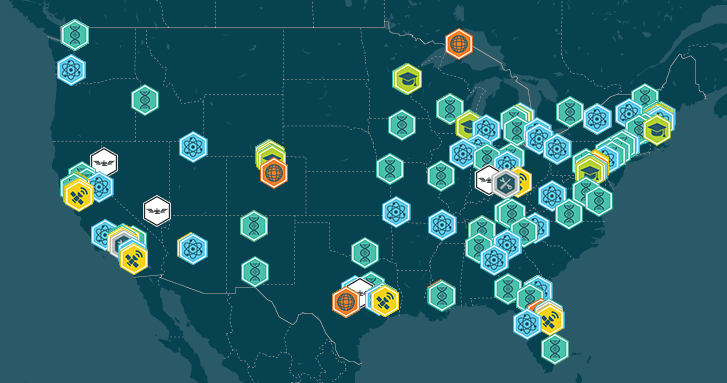At a Glance
- More than 500 investigations have launched to the ISS National Lab under CASIS management, including more than 60 payloads delivered this year.
- Despite a six-month period with only one crew member available for R&D, this year's crew-time utilization of more than 750 hours is slightly higher than the five-year average of 735 hours per year.
- In-orbit activities this year included investigations from Fortune 500 companies, top medical universities, and others.
- Investigations reflect a diversity of funding sponsors, including Boeing, DARPA, NSF, NIH, and the National Stem Cell Foundation.
The ISS National Lab continued to maximize utilization and science return in fiscal year 2020 (FY20), despite facing challenges including the global pandemic and briefly reduced crew availability on station (as part of the transition for crew launch to the NASA Commercial Crew Program, which will ultimately increase crew time available for research on the ISS). Including the more than 60 payloads delivered this year, a total of 449 payloads have been delivered to the ISS National Lab since its transition to nonprofit management, representing more than 500 investigations launched over the nearly 10 years of CASIS operations.
The percentage of these payloads that represent projects from the private sector has steadily increased over the past decade, reaching more than 80% in FY20 and averaging approximately 70% over the past five years. Often, these investigations are fully funded by the research team or corporate sponsors. Examples of in-orbit activities associated with FY20 payloads include the following:
- As part of the historic SpaceX Demo-2 mission in July, NASA astronauts Douglas Hurley and Robert Behnken conducted two microfluidic science experiments from startups funded through the Boeing Technology in Space Prize (Qlibrium [formerly Cam Med; West Newton, MA] and 1Drop Diagnostics [Boston, MA]) as well as an investigation from Delta Faucet Company (Indianapolis, IN) that sought to improve its commercially available H2OKinetic® shower head technology.
- Several companies continued investigations focused on ZBLAN optical fiber production in space, and FOMS (San Diego, CA), the first company to hold a patent for technology to produce ZBLAN fibers in space, launched additional investigations twice in FY20.
- TIME (New York, NY), in collaboration with Felix & Paul Studios (Santa Monica, CA), filmed a virtual reality series onboard the ISS, called “Space Explorers: The ISS Experience.”
- Techshot (Greenville, IN) used its BioFabrication Facility (BFF, the first U.S. bioprinter in space) to print a large volume of human heart cells into tissue-like constructs as well as a meniscus (the C-shaped cartilage of the knee) in space.
While some projects are fully automated, most require ISS crew members to meet the investigation’s goals. This year, ISS National Lab investigations used 104% of the NASA-allocated crew time for R&D, reflecting more than 750 hours of work on exciting R&D aimed at benefitting people on Earth and advancing the economic development of LEO.
This year’s crew-time utilization is slightly higher than the five-year average of 735 hours (albeit slightly less than the recording-breaking utilization in FY19 of nearly 1,000 hours)—but this number is notable considering there was only one crew member available for R&D activities for half the year. Availability of crew time fluctuates depending on a variety of factors, but CASIS has maintained more than 100% utilization in three of the past five years (FY17, FY19, and FY20).

Payloads are delivered as part of Commercial Resupply Services (CRS) missions, four of which launched in FY20:
- Northrup Grumman CRS-12 launched more than 20 payloads, including a radiation shielding technology demonstration from Lockheed Martin Corp. (in collaboration with StemRad) and a reflight of student research sponsored by Boeing through the Genes in Space yearly competition—this time building on the team’s FY19 first-ever use of CRISPR gene editing technology in space.
- SpaceX CRS-19 carried diverse payloads including Mighty Mice in Space (rodent research sponsored by The Jackson Laboratory), the latest Anheuser-Busch investigation, and research from Aspen Neuroscience (funded by the National Stem Cell Foundation) related to Parkinson’s disease and multiple sclerosis. Additionally, the return of SpaceX CRS-19 delivered home research from adidas and multiple investigations funded by the NSF.
- Northrup Grumman CRS-13 payloads included low-cost microsatellites developed by the DARPA, a student investigation in crop science and symbiosis, and a tissue and cell culturing facility (Mobile SpaceLab, from HNu Photonics).
- SpaceX CRS-20 included more research from adidas (materials science for improved athletic shoe technology), cardiac stem cell research from Emory University, feedstock for the meniscus bioprinting using the BFF, and other investigations—and the descent flight brought home investigations including rodent research samples from Baylor College of Medicine and several NIH-sponsored investigations from the Tissue Chips in Space initiative.




